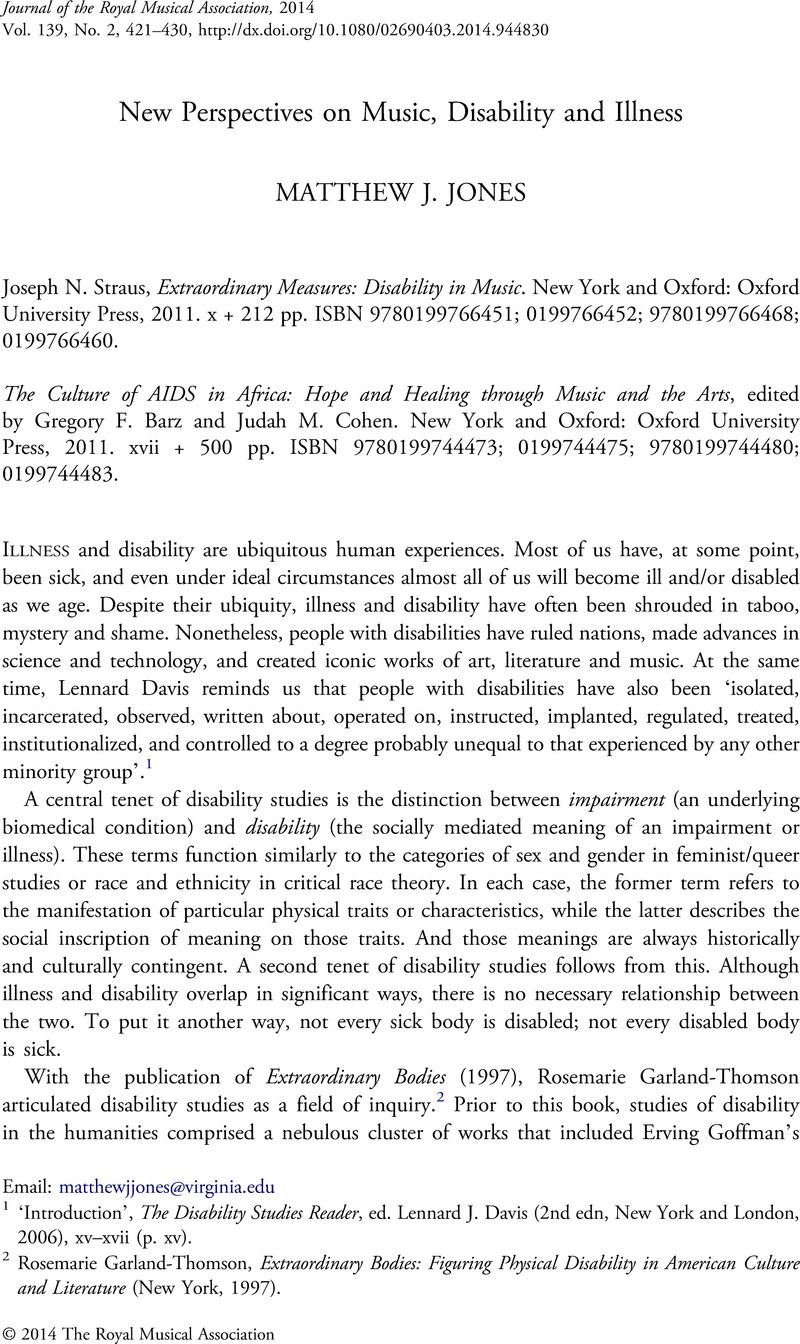No CrossRef data available.
Article contents
New Perspectives on Music, Disability and Illness
Published online by Cambridge University Press: 01 January 2014
Abstract

- Type
- Review Article
- Information
- Copyright
- Copyright © 2014 The Royal Musical Association
References
1 ‘Introduction’, The Disability Studies Reader, ed. Lennard J. Davis (2nd edn, New York and London, 2006), xv–xvii (p. xv).
2 Rosemarie Garland-Thomson, Extraordinary Bodies: Figuring Physical Disability in American Culture and Literature (New York, 1997).
3 This list is, of course, only partial. See Erving Goffman, Stigma: Notes on the Management of Spoiled Identity (Harmondsworth, 1963); Sander L. Gilman, Seeing the Insane: A Cultural History of Madness and Art in the Western World (New York, 1982); idem, Disease and Representation: Images of Illness from Madness to AIDS (Ithaca, NY, 1988); Susan Sontag, Illness as Metaphor and AIDS and its Metaphors (repr. New York, 2001); Kaja Silverman, The Acoustic Mirror: The Female Voice in Psychoanalysis and Cinema (Bloomington, IN, 1988). Crimp's influential articles about AIDS have been anthologized in his Melancholia and Moralism: Essays on AIDS and Queer Politics (Boston, MA, 2006).
4 Garland-Thomson, Extraordinary Bodies, 6.
5 Garland-Thomson, Extraordinary Bodies, 9.
6 George McKay, ‘Introduction: Special Issue on Popular Music and Disability’, Popular Music, 28 (2009), 293–5 (p. 293).
7 George McKay, ‘Introduction: Special Issue on Popular Music and Disability’, Popular Music, 28 (2009), 293–5 (p. 293).
8 Tobin Siebers, ‘Disability in Theory: From Social Constructionism to the New Realism of the Body’, The Disability Studies Reader, ed. Davis, 173–84, offers further insight into the ways in which academic co-option of disability perspectives often overlooks ‘the reality of the disabled body’ and the basic struggles people with disabilities face in simply functioning in the world. Siebers writes: ‘The disabled body is no more real than the able body – and no less real. In fact, serious consideration of the disabled body exposes that our current theories of reality are not as sophisticated as we would like to think. They prefer complexity to simplicity, but they lop off a great deal of reality in the process, most notably the hard simple reality of the body […]. The challenge is to function […]. People with disabilities want to be able to function: to live with their disability, to come to know their body, to accept what it can do, and to keep doing what they can for as long as they can’ (p. 180).
9 Maynard Solomon, ‘Franz Schubert and the Peacocks of Benvenuto Cellini’, 19th-Century Music, 12 (1988–9), 193–206. Solomon's article prompted passionate responses from both sides of the argument. Rita Steblin's defensive ‘The Peacock's Tale: Schubert's Sexuality Reconsidered’ appeared in 19th-Century Music, 17 (1993–4), 5–33, and a year later she composed a letter to the editor of the New York Review of Books that elicited a response from Charles Rosen. More recently, Steblin included a jibe at Solomon in ‘Schubert's Pepi: His Love Affair with the Chambermaid Josepha Pöcklhofer and her Surprising Fate’, Musical Times, 149 (2008), 47–69. See also Kristina Muxfeldt, ‘Political Crimes and Liberty, or Why Would Schubert Eat a Peacock?’, 19th-Century Music, 17 (1993–4), 47–64.
10 Quoted in Solomon, ‘Franz Schubert and the Peacocks of Benvenuto Cellini’, 194.
11 Benjamin D. Koen, Gregory Barz and Kenneth Brummel-Smith, ‘Introduction: Confluence of Consciousness in Music, Medicine, and Culture’, The Oxford Handbook of Medical Ethnomusicology, ed. Benjamin D. Koen, Jacqueline Lloyd, Gregory Barz and Karen Brummel-Smith (Oxford, 2008), 3–17 (p. 3).
12 Benjamin D. Koen, Gregory Barz and Kenneth Brummel-Smith, ‘Introduction: Confluence of Consciousness in Music, Medicine, and Culture’, The Oxford Handbook of Medical Ethnomusicology, ed. Benjamin D. Koen, Jacqueline Lloyd, Gregory Barz and Karen Brummel-Smith (Oxford, 2008), 3–17 (p. 3).
13 Gregory Barz, Singing for Life: HIV/AIDS and Music in Uganda (New York, 2006), 6.
14 Gregory Barz, Singing for Life: HIV/AIDS and Music in Uganda (New York, 2006), xxvi.
15 Writers like Larry Kramer turned to the US gay press in the early 1980s to raise awareness about the epidemic. Douglas Crimp began to articulate critical theories about AIDS and art in the mid-1980s, and many others followed. For more about specifically musical responses to HIV/AIDS, see my Ph.D. dissertation, ‘How to Make Music in an Epidemic: Hearing AIDS, 1981–1996’ (University of Virginia, 2014). Kramer's AIDS writings have been anthologized in Reports from the Holocaust: The Making of an AIDS Activist (New York, 1989), and Crimp's anthology Melancholia and Moralism is an excellent source.
16 Evelynn M. Hammonds and Cathy Cohen have argued that heterosexual minority women are often misrepresented in HIV statistics in the US because they are relegated to one of three categories: drug user; partner of a drug user; or a mother who transmitted HIV to her child. They posit that heterosexual transmission of HIV, particularly among people of colour and minorities, may be under-reported in general. See Evelynn M. Hammonds, ‘Missing Persons: African-American Women, AIDS, and the History of Disease’, Words of Fire: An Anthology of African-American Feminist Thought, ed. Beverly Guy-Sheftall (New York, 1995), 434–50, and Cathy Cohen, The Boundaries of Blackness: AIDS and the Breakdown of Black Politics (Chicago, IL, 1999).
17 Paul Attinello, ‘Fever/Fragile/Fatigue …’, Sounding Off: Theorizing Disability in Music, ed. Neil Lerner and Joseph Straus (New York, 2006), 13–22.
18 Rather than deny the existence of AIDS, US conservatives like Senator Jesse Helms chose to ignore it. When this tactic no longer worked, they actively fought to withhold funding for AIDS research and treatment.
19 Barz, Singing for Life, 4.




